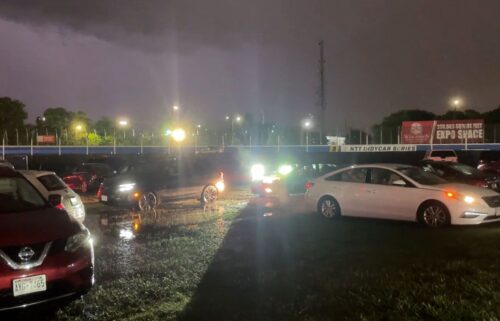The weather most likely to ruin your flight plans
By Mary Gilbert, CNN Meteorologist
(CNN) — Chances are, you can blame the weather if your flight plans get upended during the holiday travel rush.
Weather is the largest cause of air traffic troubles in the US and accounts for 75% of all reported delays, according to the Federal Aviation Administration.
But not all weather is created equal when it comes to flight disruptions. Here are the four types of weather most likely to change up your itinerary, ordered from least to most-likely, according to Kyle Struckmann, the head aviation meteorologist for the National Weather Service.
4. Wild winds
Both wind speed and wind direction are critical for safe takeoffs and landings.
“Airplanes ideally land and take off directly into the wind,” Struckmann told CNN.
Headwinds give a plane the lift and stability necessary for smooth takeoffs and landings. Without them, planes run the risk of not getting off the ground or landing too fast.
Airport runways are ideally built to run in the same direction as the airport’s most common wind direction, according to the FAA. This allows aircraft to take off and land into the wind more often.
Strong crosswinds – winds that blow across an airplane’s path, rather than toward its nose or tail – can cause tricky or aborted landings by forcing the aircraft to approach the runway at an angle to counterbalance the winds’ force and land level.
Crosswinds are a frequent cause of rough landings, Struckmann said. In a more extreme scenario, planes can miss the runway entirely.
One such landing played out in California during Tropical Storm Hilary in August. A passenger jet came in for a landing off-kilter during poor weather conditions and struck its left wing on the runway as scared, but unharmed, passengers watched sparks fly.
Busy airports have alternate runways for when the wind direction is not ideal, but alternate runways are often shorter and accommodate fewer planes, according to Struckmann.
Fewer landings mean longer flight times for planes waiting to land and longer wait times for passengers at the gate waiting for their plane to arrive.
3. Low visibility
Many different types of weather, including dense fog, heavy rainfall with low clouds, and heavy snow, can drop visibility to near-zero and frequently cause delayed takeoffs and landings.
Even though pilots use instrumentation to fly safely through clouds when they cannot see, good old-fashioned eyesight is still a necessary fail-safe near a runway.
Different airports have different requirements, but to land, pilots need to be able to see enough of the runway to note potential hazards instrumentation may not be able to detect as quickly, according to Struckmann.
These potential hazards include other aircraft being where they’re not expected to be.
In January, two airliners nearly collided at New York’s John F. Kennedy International Airport after one crossed onto an active runway. Two other near misses happened in the following weeks in Honolulu and Austin, Texas.
2. Snow and ice
Snow and ice is one of the most frequent weather hazards from late fall through winter and causes serious issues for planes on the ground and in the air.
On the ground, the focus is on clearing runways of slick snow to allow planes to safely grip the surface during takeoffs and landings.
In the air, it’s all about keeping ice from accumulating on planes.
“When you have ice accumulating on wings, it really significantly affects a plane’s performance,” Struckmann said.
When ice gathers on an aircraft, it can distort the flow of air over the wings – disrupting the lift that keeps planes in the air – and make a plane heavier. Too much ice can cause an airplane to roll or maneuver uncontrollably, according to the FAA.
Clouds are made up of water droplets. These droplets can freeze and cause ice to accumulate on a plane when it flies through clouds at a height where temperatures are below freezing.
“If planes have to descend through [freezing conditions] then ideally the plane needs to move through it as fast as possible to get down to a lower altitude where it’s above freezing,” Struckmann explained.
Back on the ground, deicing clears any ice or snow build up off a plane so it can operate safely. This process can delay takeoffs, but it beats not being able to lift off at all or losing control mid-flight.
1. Thunderstorms
While more common in spring and summer, the holiday season is not immune to thunderstorms. A secondary severe weather season develops in November and December due to the clash of still-warm air from the Gulf of Mexico with very chilly air diving south out of Canada.
The resulting thunderstorms are “very dangerous” for air travel, Struckmann said. This is due to the “severe turbulence caused by updrafts, downdrafts, winds and hail.”
Thunderstorms contain both updrafts and downdrafts, fast-moving columns of air that rush up into the atmosphere and down toward the surface, respectively. These quickly-changing winds create severe turbulence and, in addition to hail and lightning, can batter an aircraft in flight.
Turbulence can cause a bumpy ride, severe shaking and sudden drops that can lead to injuries. At its worst, turbulence can hinder a plane’s ability to fly by altering its speed or altitude and even cause it to crash, according to the World Meteorological Organization.
To avoid damage and potential passenger injuries, planes typically take a longer flight plan that travels around – rather than through – thunderstorms to avoid the hazards found within the disruptive storms. This leads to more time spent in the air and later arrivals back on the ground, which may delay subsequent flights.
During the spring, flying earlier in the day before thunderstorms rumble to life in the heat of the afternoon can help avoid delays.
The-CNN-Wire
™ & © 2023 Cable News Network, Inc., a Warner Bros. Discovery Company. All rights reserved.

